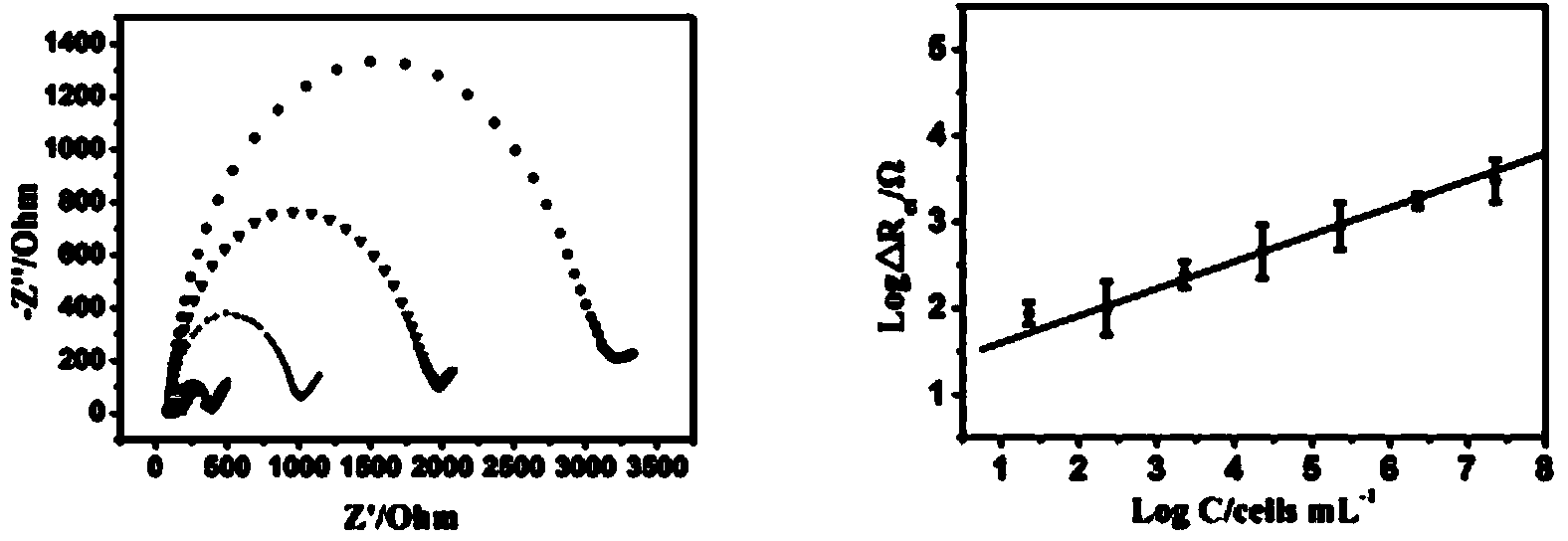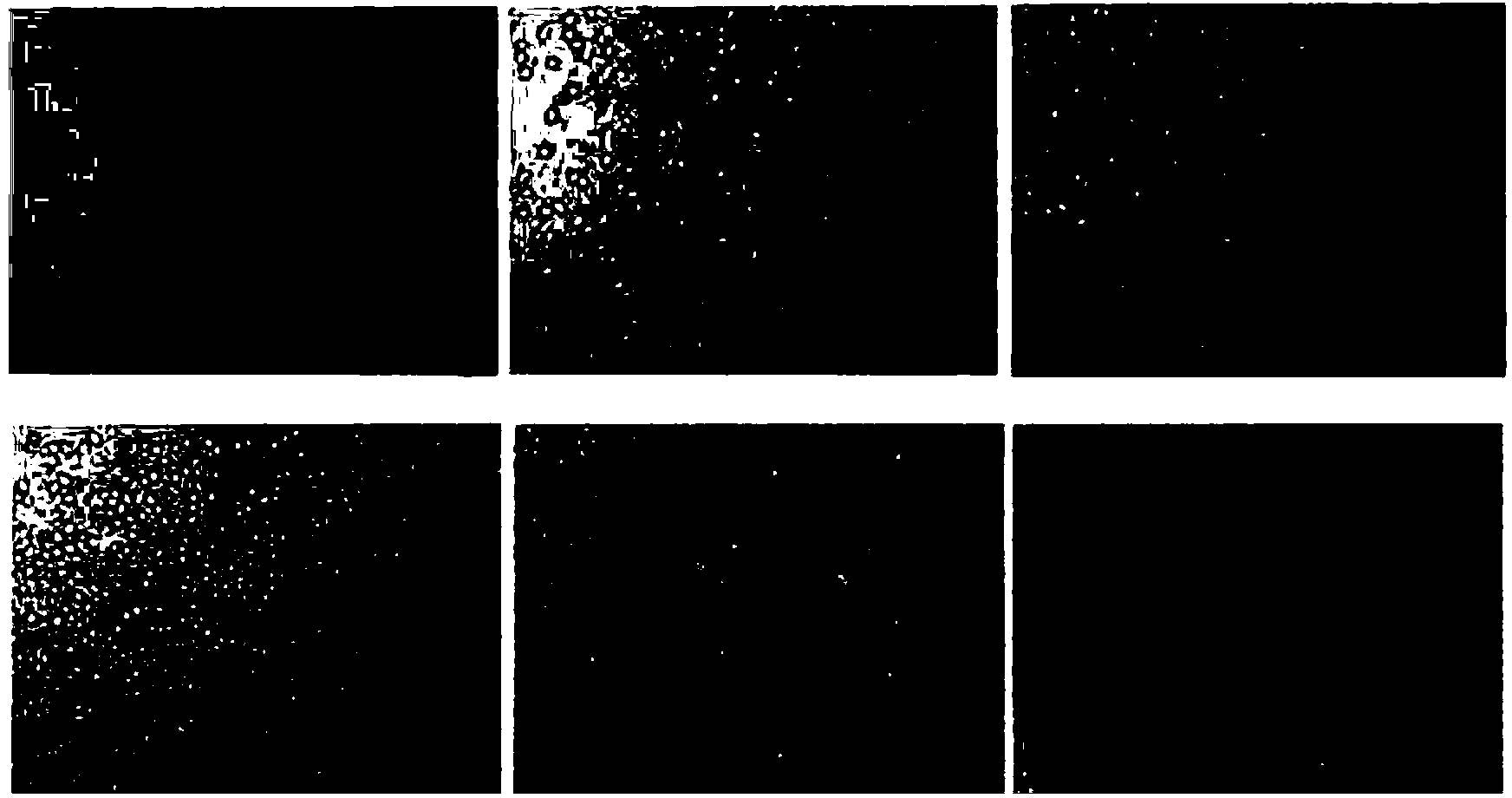Electro-chemical cell sensor with double targeting and visual functions and preparation method thereof
A cell sensor and electrochemical technology, applied in the field of electrochemistry, can solve the problems of large scale, high cost, and time-consuming, etc., and achieve the effect of increasing the binding site, good conductivity, and high transparency
- Summary
- Abstract
- Description
- Claims
- Application Information
AI Technical Summary
Problems solved by technology
Method used
Image
Examples
Embodiment 1
[0022] Embodiment 1: the preparation of sensor
[0023] 1. Functionalization of multi-walled carbon nanotubes: First, ultrasonically ultrasonicate the multi-walled carbon nanotubes in a 3:1 mixture of sulfuric acid and nitric acid for 16 hours, then filter and wash them with deionized water until the filtrate is neutral, and vacuum conditions Tumble dry.
[0024] 2. ITO glass surface pretreatment: First, put the ITO glass into twice distilled water, acetone, isopropanol, ethanol, and twice distilled water for 15 minutes, and then prepare ammonia water: hydrogen peroxide (NH3 ·H 2 O:H 2 o 2 =1:1) boil in the solution for 30min;
[0025] 3. Amination of ITO electrode surface: quickly add 10mM p-phenylenediamine solution to 1M NaNO under ice bath conditions 2 In the solution, react in the dark for 3 minutes to synthesize a diazonium cation solution, pour it into the electrolytic cell, and the detection solution is prepared from a 10mM pH7.4 PBS solution containing [Fe(CN 6 )...
Embodiment 2
[0028] Example 2: Electrochemical Behavior and Atomic Force Microscopy (AFM) Characterization of the Sensor Construction Process
[0029] During the electrode modification process, the dual qualitative methods of electrochemical cyclic voltammetry and electrochemical impedance were used for characterization. First, the treated bare ITO electrode is placed in the detection cell, and as the surface of the electrode is gradually modified with p-phenylenediamine (AP), MWCNTs, small molecule A S C 8 h 10 NS 2 , in 10 mM pH 7.4 PBS containing 5 mM K 3 Fe(CN) 6 and 0.1M KCl solution (sweep rate: 100mV s -1 ) for cyclic voltammetry detection, the current value gradually decreased; in 10mM pH7.4PBS containing [Fe(CN 6 )] 3- / [Fe(CN 6 )] 4- (10mM, 1:1) and 0.1M KCl solution for electrochemical impedance (0.1-10 5 Hz) detection, the corresponding electron transfer resistance R et Gradually increased; combined with the AFM spectrum ( figure 1 ), the surface height of ITO gradu...
Embodiment 3
[0030] Example 3: Targeted Molecular Probe A S C 8 h 10 NS 2 Study on Specificity of ITO Sensors Modified by Labeled Three-dimensional Carbon Nanotubes
[0031] 1. The bare ITO electrode, AP-ITO electrode, 3D-MWCNTs / ITO electrode, A S C 8 h 10 NS 2 The 3D-MWCNTs / ITO electrodes were soaked in 1mL HL-60 cell suspension respectively, and placed in a cell culture incubator (37°C, 5% CO 2 Humidified atmosphere) for 3 hours of incubation, PBS was used to wash away non-specifically bound cells, and the electrode was placed in the detection cell for electrochemical impedance detection. Bare ITO electrodes, AP / ITO electrodes have basically no electrochemical response, 3D-MWCNTs / ITO electrodes have weak electrochemical response signals, MWCNTs have a small amount of non-specific adsorption to cells, A S C 8 h 10 NS 2 Electron transfer resistance R of 3D-MWCNTs / ITO electrode et significantly increased, indicating that the A S C 8 h 10 NS 2 Small molecule probes have the a...
PUM
 Login to View More
Login to View More Abstract
Description
Claims
Application Information
 Login to View More
Login to View More - R&D
- Intellectual Property
- Life Sciences
- Materials
- Tech Scout
- Unparalleled Data Quality
- Higher Quality Content
- 60% Fewer Hallucinations
Browse by: Latest US Patents, China's latest patents, Technical Efficacy Thesaurus, Application Domain, Technology Topic, Popular Technical Reports.
© 2025 PatSnap. All rights reserved.Legal|Privacy policy|Modern Slavery Act Transparency Statement|Sitemap|About US| Contact US: help@patsnap.com



